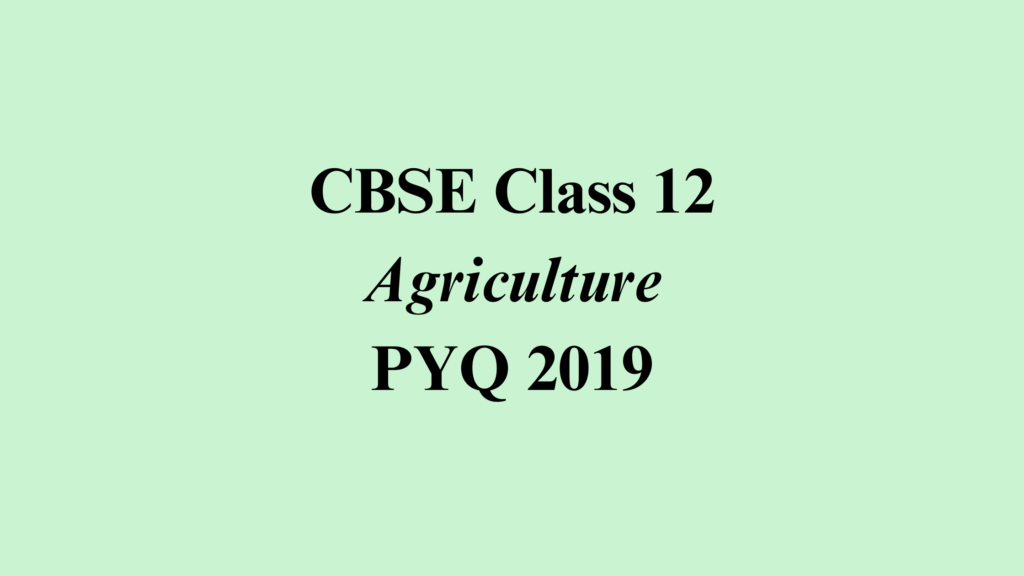Class 12 Agriculture PYQ 2019 Solved
Time Allowed: 3 hours
Maximum Marks: 70
1 Mark Questions
1. Name the by-product obtained after extraction of oil from oilseed by mechanical oil expeller.
Ans: Oilseed cake
2. Name one fruit from which morabba can be made.
Ans: Any fruit, like aonla, apple
3. Define maturity index.
Ans: Ripening is the physiological process by which fruits attain their desirable flavour, quality, colour, palatable nature, and other textural properties.
4. Who discovered the bee dance?
Ans: Karl Von Frisch
5. Write the name of one grass suitable for lawn.
Ans: Cynodon dactylon or Hariyali or Doop
6. Name the bee caste responsible for egg-laying.
Ans: Queen
7. Which State has become India’s first fully organic state?
Ans: Sikkim
8. Name the preservative used in preservation of fruit jam.
Ans: Sugar
9. Chemical preservation is a better form of preservation than pasteurization to preserve squash and cordial. Justify.
Ans: Because pasteurization gives a cooked flavor. Chemical preservatives increase shelf life better.
2 Marks Questions
10. Discuss any two problems faced by Indian Food Industry.
OR
Why is washing of fruits essential before processing?
Ans:
- Lack of infrastructure for post-harvest handling and storage.
- Absence of a cold chain facility.
- lack of technical support.
- Poor credit facility by the financial institution for the setting up of a plant.
11. List any two good characteristics that spawn should have.
Ans: Characters of good spawn:
- Proper coating of mycelium around each grain.
- The growth of fresh spawn is more or less whitish. There should not be any slimy growth or greenish or blackish spots in the spawn, as this indicates bacterial or fungal contamination, respectively.
12. What is vermicompost ? How is it beneficial to farmers?
Ans: Vermicompost is the production of compost using earthworms. The vermicompost is rich in plant nutrients and other factors that help in plant growth and crop yield. Improvement of soil texture.
13. Organic farming is beneficial to the crops. Justify.
Ans: Any two
- Organic manures provide optimal growing conditions.
- Organic manure supplies most of the macro nutrients and micronutrients.
- It improves the soil’s physical, chemical, and biological properties of soil.
- There is an effective use of byproducts.
14. Why is waxing recommended to increase the shelf life of fresh fruits and vegetables?
Ans: Any two
- Reduces moisture loss and shivering with reduced postharvest losses.
- Improves product appearance.
- Does not allow easy growth of mould on the fruit surface.
3 Marks Questions
15. Enlist three value added products that can be made from the following :
(a) Vegetables
(b) Floricultural crops
Ans: Any three
Vegetables:
- Pickle
- Frozen vegetables(pea)
- tomato ketchup
- potato chips
- Morabba (carrot)
Floricultural crops
- Rose water
- Gulkhand
- Essential oil
- Flavour and Fragrance
- Dry flowers
- Insecticidal compounds
16. Discuss the importance of the following :
(a) Azolla
(b) Rhizobium
(c) Azotobacter
Ans: (a) Azolla:
- Free-floating freshwater fern
- Supply 30-40 kg N/ha
- Thrive well at low temperatures can also be applied as manure. Rice paddy fields are an ideal environment for Azolla.
- Improve yields by 15-20 per cent.
- found to be a very nutritious and cheap organic feed substitute for dairy cattle
(b) Rhizobium
- Symbiotic bacteria capable of fixing atmospheric nitrogen form an association with the roots of leguminous plants
- They are the most efficient biofertilizer as per the quantity of nitrogen fixed.
- They have seven genera and are highly specific to form nodules in legumes, referred to as the cross-inoculation group.
(c) Azotobacter
- It is an important and well-known free-living nitrogen-fixing (non-symbiotic) aerobic bacterium.
- It is used as a Bio-Fertilizer for all non-leguminous plants, especially rice, cotton, vegetables, etc.
- Increases yield
- The lack of organic matter in the soil is a limiting factor for the proliferation of Azotobacter in the soil.
17. Describe the various post-harvest operations in oil seed crops.
Ans: Description should cover the following irrigation methods
- Cleaning
- Drying to reduce soil moisture
- To extract oil and oil cake for feeding to cattle
- Packaging, labeling, storage, and marketing.
18. Explain any two methods of lawn making.
Ans: Any two methods:
(1) Seeding
- seeds of doop grass, which is fast spreading
- 30 kg of seed is required for planting in one hectare.
- The field is divided into small plots, seed is mixed with soil and then spread over the field.
- Light watering should be given. Avoid flood irrigation
(2) Turfing
- Turf is a piece of earth with compact grass on them
- turf is removed along with the earth and cut uniformly into small pieces.
- placed on the lawn site and beaten down.
(3) Turf plastering
- Grass chopped into small bits, i.e., 5-7 cm long.
- mixed well with garden soil.
- spread uniformly and water lightly
19. Discuss the various methods of fertilizer application.
Ans: Answer should be based on the following points
Application of solid fertilizer
- Broadcasting
- Basal application
- Top dressing
- Placement
- Plough sole placement
- Deep placement
- Localised placement
- Band placement
- Foliage applications
20. Differentiate between Jam and Jelly.
Ans:
| Jam | Jelly |
| Made from fruit pulp | Made from the clarified fruit juice containing pectin. |
| Opaque in nature | Translucent or transparent in nature |
| The end product is less firm than jelly | The end product is firmer than jam |
| Solid | Gel-like |
21. Fertilizers are applied to crops to fulfill the various requirements of plant nutrients. Write any three functions and deficiency symptoms of potassium in plants.
Ans: Any three
Function of potassium in plants
- Reduces lodging of cereal crops
- Regulates the opening and closing of stomata
- Regulates the movement of sugars and ions
- Activates enzymes and helps in enzyme synthesis
- Regulate water imbalances within the plant
- Regulate the uptake of CO2
Deficiency of potassium
- Stunted growth with short internodes
- Reduced rate of photosynthesis
- chlorosis, yellowing of leaves and leaf scorch
- Poor yield
OR
Write any three functions and deficiency symptoms of iron in plants.
Function of iron in plants
- Help in the synthesis of chlorophyll.
- Structural component of certain biomolecules like cytochromes.
- Constituent of certain enzymes e.g., catalase.
- Helpful in the absorption of other nutrients
Deficiency of iron
- Interveinal chlorosis. Later, the yellowing of leaves
- Symptoms first appear in the lower leaves.
- Reduced yield due to poor photosynthesis.
5 Marks Questions
22. (a) Write two major components of soil.
(b) Outline the various steps of soil sampling.
Ans: (a) Abiotic components: air and water
Biotic component: Microorganism
(b) Description of the following points
Divide the field into different homogeneous units
↓
Remove surface litter
↓
Drive the auger or give a V-shaped cut up to 15cm deep
↓
Mix samples thoroughly and remove debris
↓
Reduce the bulk by compartmentalization
↓
Collect the sample and store it in a clean polythene bag
↓
Label the bag with the required information.
23. Discuss the demerits of drip irrigation.
Ans: Any five
Disadvantages of drip irrigation
- The expense, especially the initial cost, is high.
- The lifetime of the tubes used in drip irrigation can be shortened by the sun heat or rodents, etc.
- Sensitive to clogging: May cause clogging of emitters if the water is saline.
- Problems in moisture distribution.
- Salinity problem.
- High skills are required for design, installation, and operation.
- Out of reach for common farmers
OR
Discuss the merits of drip irrigation.
Ans: Advantages of drip irrigation (Any five)
- Enhanced crop yield and crop yield.
- Compact and efficient root system.
- Water saving and higher water application efficiency.
- Fertigation possible, minimum nutrient loss’
- Suitable for irrigating higher value crops.
- Limited weed growth.
- Saves energy
24. What is fruit jam? Describe the various steps in preparation of fruit jam.
Ans: Jam is a product made by boiling fruit pulp with a sufficient quantity of sugar to a reasonably thick consistency, firm enough to hold the fruit tissues in position. The FPO specification of jam is 68.55 TSS,45% of fruit pulp, and 0.5-0.6% of acid ( citric acid ) per 100gm of the prepared product.
The answer is to be based on the following points
Process:
Selection of Ripe firm fruits → Washing → Peeling → Pulping (Remove seed and core) → Addition of reauired sugar and acid → Boiling (with continuous stirring) → Judging of end point by further cooking upto 105 C or 69% TSS or by sheet test → Filling cooked pulp hot into sterilized bottles → Cooling → Waxing → Capping →Labeling →Storage ( at ambient temperature).
25. Write the five precautions to be taken while making fruit jam/jelly.
Ans: Answer should be based on the following points (Any five)
Precautions while making jelly
- The proper amount of sugar and pectin
- The correct amount of acid to be added
- Cooking time should be correct, which is judged by various endpoints
- Immature or overripe fruits should not be selected
- Filtration should be done using of fine and clean cloth to get clarified juice.
- Pouring should be done slowly so as to avoid trapping air bubbles.
- Scum if formed should be removed periodically.
OR
Describe the various problems associated with jam or jelly preparation.
Problems associated with jelly making
- Crystallization: Due to a lower percentage of invert sugar
- Sticky or gummy Jam: High % TSS
- Premature setting: Due to low %TSS and high pectin content
- Surface graining and shrinkage: evaporation of moisture
- Microbial spoilage during storage: improper packaging
26. What are the important characteristics of grass to be used in lawn-making?
Ans: Any five
Characteristic of grasses for lawn making
- The grass selected should be spreading one.
- They should remain green throughout the year.
- They should be soft and appealing to the eyes.
- They should be resistant to drought, cold, salinity, and various pests and diseases.
- Grasses should not be pointed one, i.e., it should pierce.
- It should be suitable for all types of soil.
- They should be easily available.
- It should not have an allergic reaction or produce allergens..
27. What is mother plant? Examine the various criteria to be kept in mind by nurserymen while selecting the mother plant.
Ans: (a) Mother plant is a permanent plant/tree in a nursery. It provides bud sticks and scions for budding and grafting operations.
(b) Criteria for Selection of Mother Plants (Any four)
- Mother plants should be vigorous, healthy, and high-yielding. It should have a regular bearing habit.
- It should be free from pests, disease,s and viruses.
- The mother plants must necessarily be genetically pure and superior in quality. They must be obtained from Registered Farms, Agriculture Universities or Government Nurseries.
- The purchase receipt of the mother plant should be preserved to prove the origin and authenticity of the mother plants.
- Mother plants should be selected according to the regional demand for nursery plants.
- Ornamental mother plants are planted under protected conditions, either under shade net or semi-shade conditions.
OR
What do you mean by certification of nursery? List the minimum standards to be followed by nurserymen for different fruit plants.
Ans: Certification of nursery means that the nursery plants have been checked and identified as true-to-type by the competent authority.
2) The general standards for different fruit plants are as under: (Any four)
- Nursery plants should be true-to-type and raised from healthy, disease-free, high-yielding progeny trees of good quality.
- Nursery plants should be raised on recommended rootstocks and should not be raised on old stock.
- The bud/graft union should be smooth and strong enough.
- The bud/graft union should be 15-25 cm above the ground level.
- Nursery plants should be of standard height (60-120 cm), depending on the kind of fruit crops.
- The root system should be well developed, and there should be no damage while uprooting the plants from the nursery.
- Nursery plants should be healthy and free from diseases and insect pests.
Additional Practice Papers
- Class 12 Agriculture Syllabus 2025-26
- Class 12 Agriculture PYQ 2024
- Class 12 Agriculture PYQ 2023
- Class 12 Agriculture PYQ 2022
- Class 12 Agriculture PYQ 2020




